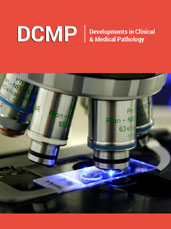- Submissions

Full Text
Developments in Clinical & Medical Pathology
A Brief Review of Pathogenesis of Endometriosis
Samad Beheshtirouy and Marzieh Marahem*
Department of Cardiothoracic Surgery, Iran
*Corresponding author: Marzieh Marahem, Department of Cardiothoracic Surgery, Iran
Submission: November 02, 2020;Published: December 01, 2020

ISSN:2690-9731 Volume2 Issue1
Introduction
Endometriosis is an estrogen-dependent benign inflammatory disease, which is characterized by presence of endometrial-type mucosa in extra-uterine sites and causes chronic inflammatory at the site of lesion [1,2]. This disease affects their quality of life, work efficiency and sexual life [3] and cause of 25-70% of severe pelvic pain, dysmenorrhea, dyspareunia and infertility [4]. the proposed pathogenic theories are including retrograde menstruation, coelomic metaplasia, induction theory [5]. According to the most covincing modle, the retrograde menstruation phenomenon is accepted theory and states that viable endometrial fragments reaching the peritoneal cavity. they can implant, grow and invade onto the peritoneum and abdominal organ, proliferate and cause chronic inflammation with formation of adhesions [6]. However, this theory also does not fully explain all cases of the disease. Therefore, there are other factors that cause the progress of disease. These factors can include environmental, genetic, hormonal, or immunological factors. Various evidence suggests that endometriosis causes numerous quantitative and qualitative changes in immune cells and their products, such as cytokines [7]. Therefore, this disease is considered as a hormonal-immunological disease. Recent studies have suggested that endometrial stem/ progenitor cells may be involved in the pathogenesis of endometriosis [8]. In the current studies have shown that menstrual blood plays a role in endometriosis [9]. Because it is a rich source of stem cells that can proliferate and differentiate into different classes. These stem cells proliferate easily and express multipotent markers such as Oct-4, SSEA-4, and c-kit at the cellular and molecular level [10].
References
- Martin DC (2020) Endometriosis concepts and theories. USA.
- Yovich JL, Rowlands PK, Lingham S, Sillender M, Srinivasan S (2020) Pathogenesis of endometriosis: look no further than John Sampson. RBMO 40(1): 7-11.
- Ezzat L (2019) Endometriosis and quality of life: an implication on psychological well-being. USA.
- Morris K (2020) Endometriosis: to excise or ablate-a systematic review.
- Köylü A, Ömeroğlu S, Dizakar SÖA, Yiğit F, Demirel MA (2020) Histopathologic examinations and a research field of endometriosis. GMJ 31: 707-711.
- Rižner TL, Penning TM (2020) Aldo-keto reductase 1C3-assessment as a new target for the treatment of endometriosis. Pharmacological Research 152: 104446.
- Huijs E, Nap A (2020) The effects of nutrients on symptoms in women with endometriosis: a systematic review. Reproductive BioMedicine Online 42(2): 317-328.
- Ottolina J, Bartiromo L, Schimberni M, Viganò P, Candiani M (2020) Pathogenesis of bowel endometriosis. Clinical Management of Bowel Endometriosis, pp. 3-11.
- Madjid TH, Ardiansyah DF, Permadi W, Hernowo B (2020) Expression of matrix metalloproteinase-9 and tissue inhibitor of metalloproteinase-1 in endometriosis menstrual blood. Diagnostics 10(6): 364.
- Bartmann A, Naccarato C, Marins M (2020) It is possible to obtain stem cells from menstrual blood. Gynecol Reprod Health 4(4): 1-5.
© 2020 Marzieh Marahem. This is an open access article distributed under the terms of the Creative Commons Attribution License , which permits unrestricted use, distribution, and build upon your work non-commercially.
 a Creative Commons Attribution 4.0 International License. Based on a work at www.crimsonpublishers.com.
Best viewed in
a Creative Commons Attribution 4.0 International License. Based on a work at www.crimsonpublishers.com.
Best viewed in 







.jpg)






























 Editorial Board Registrations
Editorial Board Registrations Submit your Article
Submit your Article Refer a Friend
Refer a Friend Advertise With Us
Advertise With Us
.jpg)






.jpg)














.bmp)
.jpg)
.png)
.jpg)










.jpg)






.png)

.png)



.png)






